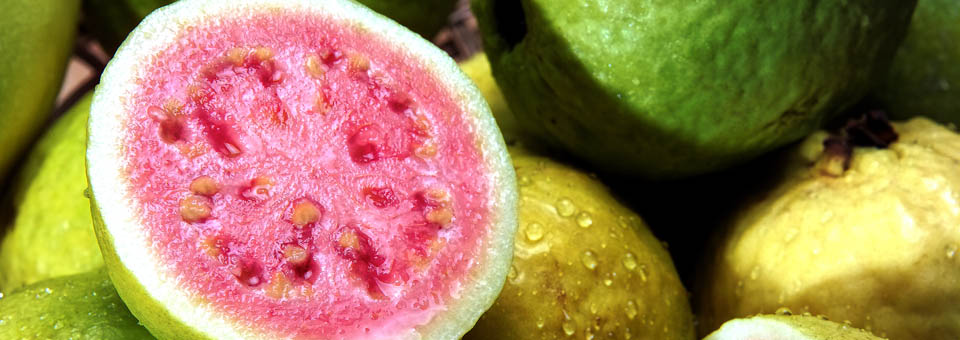Some
of my patients who travel overseas come back with horror stories. Local food and water can wreak havoc on your intestines. You can wind up with nausea and diarrhea.
In Bali and other parts of Asia, guava leaves are a common treatment for diabetes.
But the first time I went to Bali, I tried every new food I could get my hands on.
I never got an upset stomach or any type of indigestion.
I credit my herbalist friend Lelir for my “good luck.” Every morning she had me eat a juicy fruit from trees that grow wild in sunny spots all over Bali. She called it Jambu Batu or Jambu Biji.
You know it as guava.
But guava is much more than a cure for an upset stomach. Today, I want to share with you a unique power of guava to help attack the modern pandemic I named Syndrome Zero.
I blame Syndrome Zero on our modern carb-heavy processed food supply.
Every time you eat carbs your pancreas has to pump out insulin to send that sugar into your cells for energy.
But when you eat too many carbs you pump out insulin constantly. It builds up in your bloodstream. Your body becomes insulin resistant.
And you become vulnerable to diabetes and every other chronic disease.
But guava is key in battling Syndrome Zero.
In Asia and Africa, guava leaves are a common folk remedy for diabetes. And modern research backs up this traditional cure…
Studies show that compounds found in guava leaves, stems and fruit can help block digestion of carbohydrates.
They inhibit your absorption of two types of sugar: maltose and sucrose. This means your body produces less insulin.
And you have better blood sugar control.1
In an animal study, an extract of guava lowered post-meal blood sugar levels by 37%.2
And in a human study, a group of pre-diabetic men took guava extract with every meal.
At the end of three months, they reduced their post-meal blood sugar by 20% compared to a control group.
They also had a significant decrease in fats and triglyceride levels in their blood. This shows their bodies were processing the carbs more efficiently.3
Another study of diabetic patients showed that drinking guava tea reduces blood sugar levels.4
Guava tea is so powerful that in Japan it has been approved to prevent and treat diabetes.
But that won’t happen any time soon in this country…
Here mainstream medicine wants you to believe the only thing you can do about diabetes is take Big Pharma’s pills or insulin shots for the rest of your life.
But for decades I’ve been helping my patients not just manage their blood sugar levels but reverse insulin resistance and diabetes.
And I do it not with drugs but with natural healing herbs like guava. I even use guava to reverse Syndrome Zero in my clinical protocol.
In the U.S., guava season runs from September through December. You can find the fresh fruit in your local market. It usually smells nice and sweet when it’s ripe. And you can eat it just like an apple. Eat the seeds, too! They’re crunchy and have a lot of nutrients in them.
But to prevent and improve Syndrome Zero, I recommend making a tea from guava leaves.
You can find guava leaf tea in your local health food store or online. You may also see the fresh leaves at a health food store, but you’re more likely to find the dried leaves. That’s okay, because they make more potent teas, infusions and decoctions anyway.
My Balinese Recipe for Guava Leaf Tea
Here’s a recipe I was taught in Bali for a guava leaf decoction. Traditional healers use it to treat a number of ailments, including diabetes.
- You need water and guava leaves in a ratio of 8 oz. of water to 1 oz. of dried leaves.
- Place the water into a pot made from non-reactive material, such as enamel or stainless steel. Do not use aluminum.
- Crush the leaves and add them to the water. Soak them for 30 minutes.
- Bring the water to a boil. Reduce the heat, and simmer with the lid off for 30 to 60 minutes or until one-quarter of the water has evaporated.
- Cool and strain the liquid. Then use a spoon to press the leaves against the strainer so you can squeeze out the last liquid. You can store the decoction in the refrigerator for up to 72 hours. But it’s best to make what you need every day.
If you like, add some honey to your guava tea. Drink a cup with every meal.
To Your Good Health,
![]()
Al Sears, MD, CNS
1. Eidenberger T., et al. “Inhibition of dipeptidyl peptidase activity by flavonol glycosides of guava (Psidium guajava L.): A key to the beneficial effects of guava in type II diabetes mellitus.” Fitoterapia. 2013.
2. Deguchi Y., et al. “Effects of extract of guava leaves on the development of diabetes in the db/db mouse and on the postprandial blood glucose of human subjects.” Nippon Nogeikagaku Kaishi. 1998.
3. Deguchi Y., et al. “Effectiveness of consecutive ingestion and excess intake of guava leaves tea in human volunteers.” J Jap Counc Adv Food Ingredients Res. 2000.
4. Asano T., Tuji A., Deguchi Y., Makino K. “Clinical effect of Guava Tea (Bansoureicha®) on diabetes patient.” Jap J Nutr Assess. 2005.

